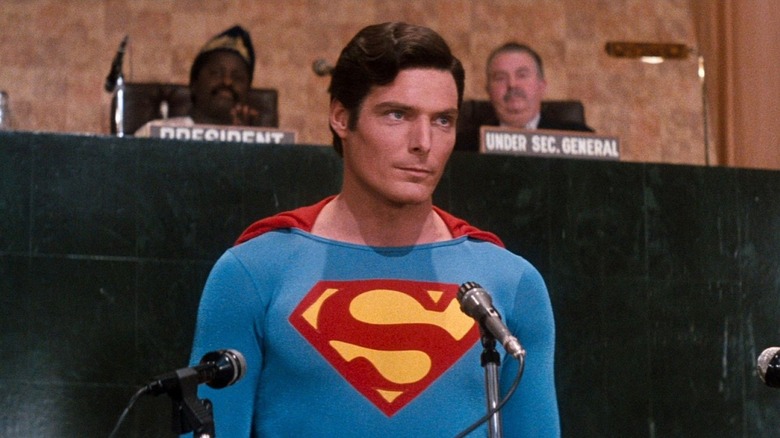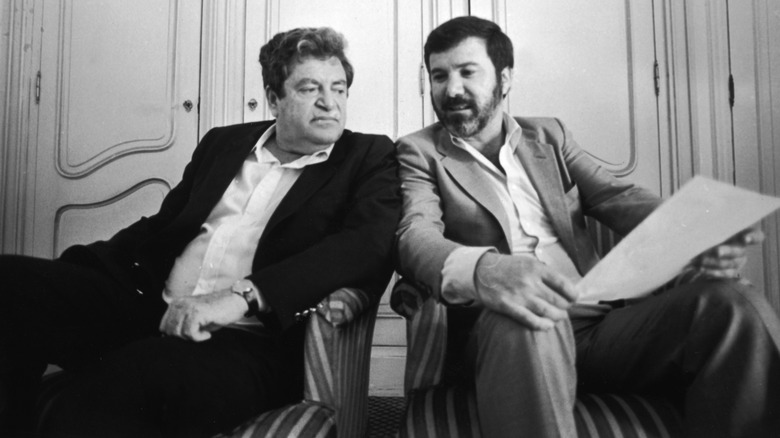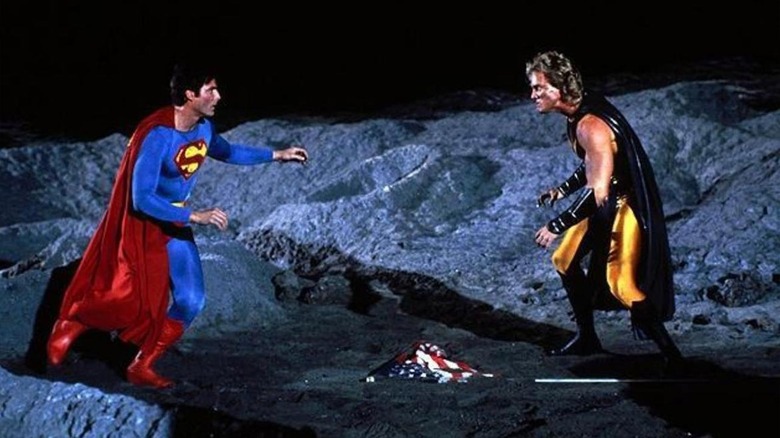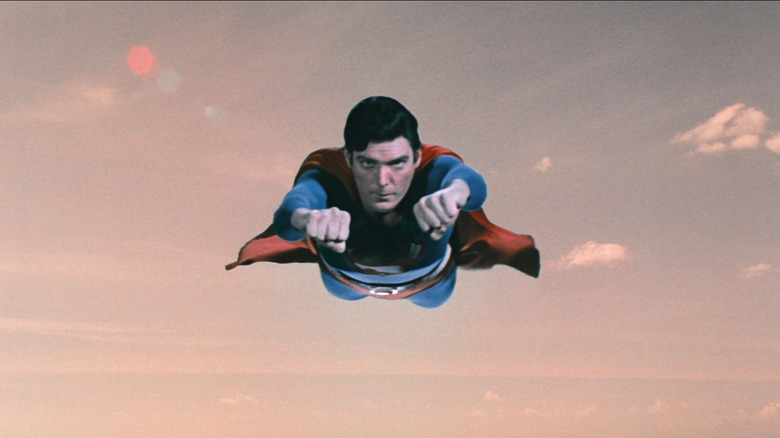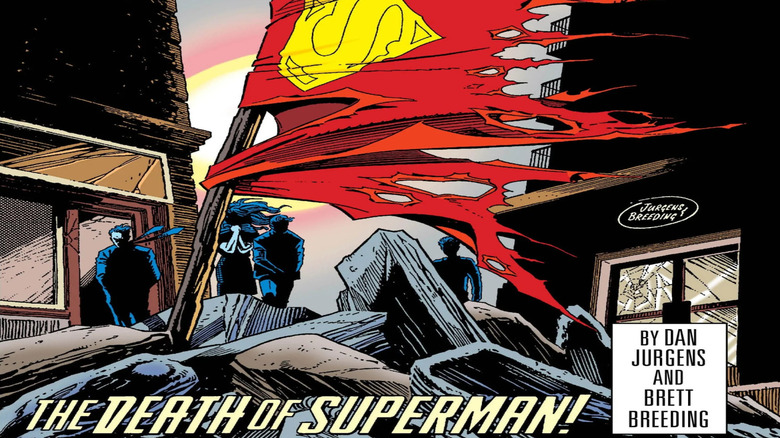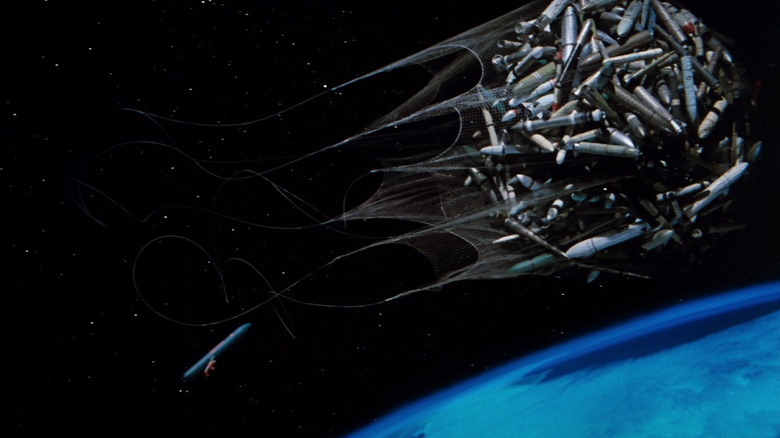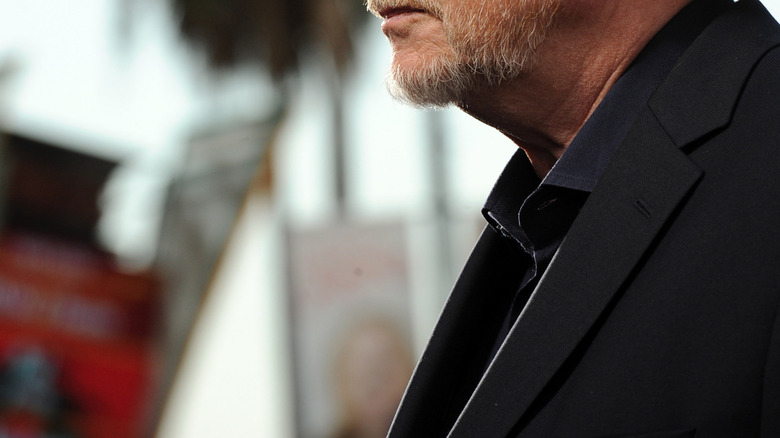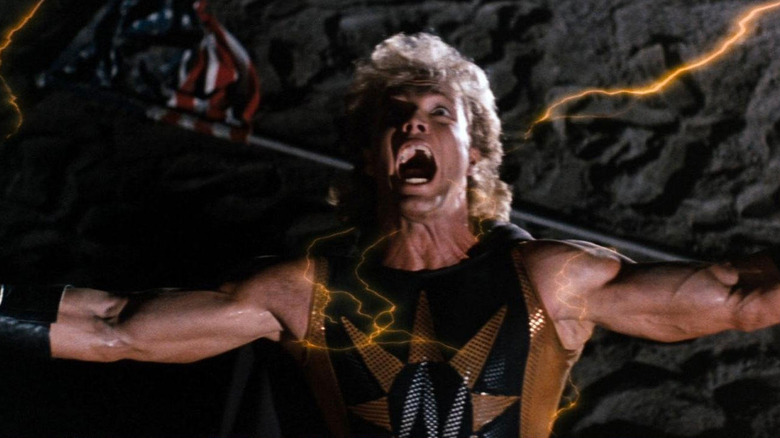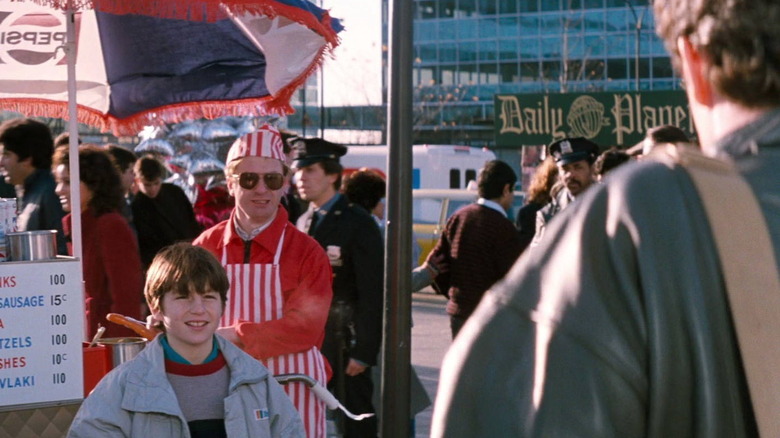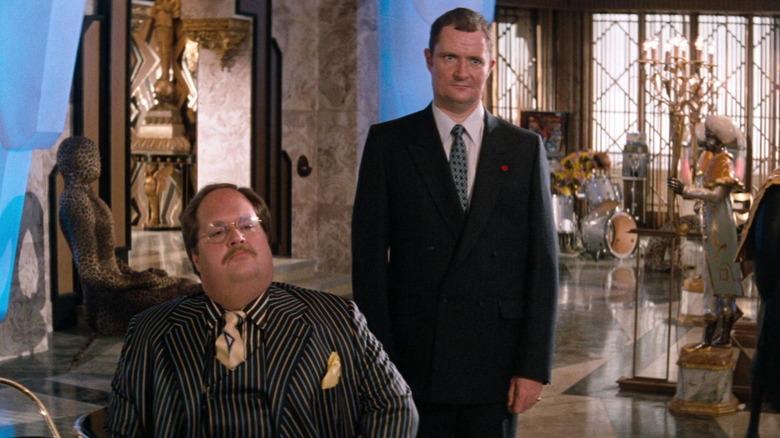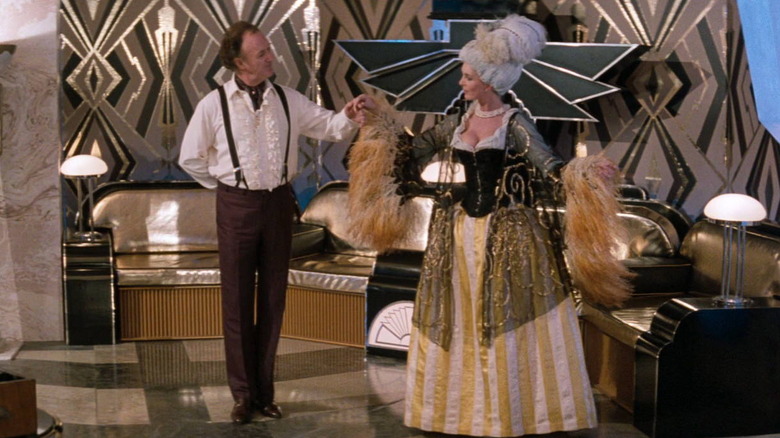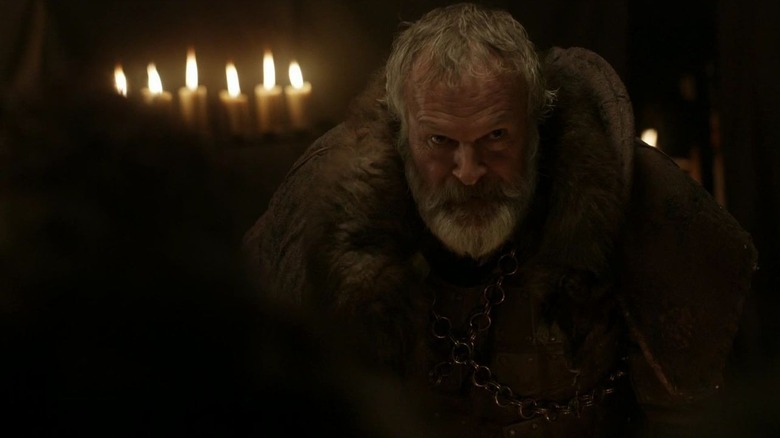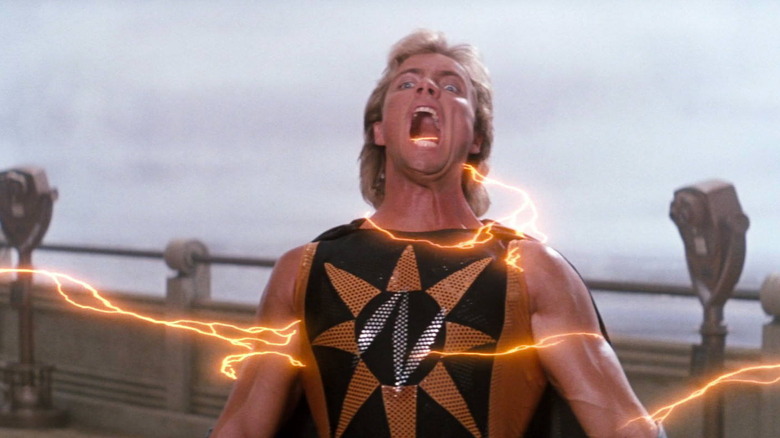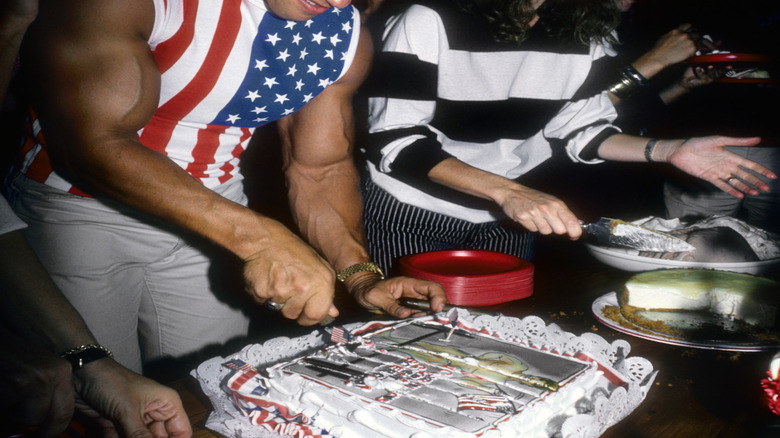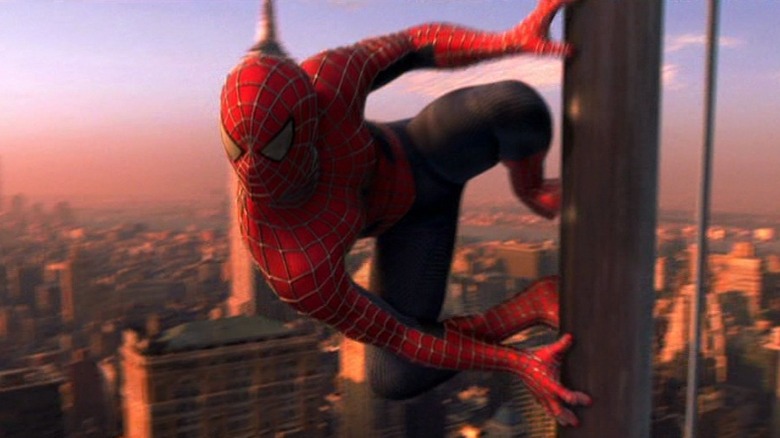Superman IV: The Quest For Peace: BTS Facts About The Worst Superman Movie Of All Time
It may be controversial to call "Superman IV: The Quest for Peace" the worst Superman film, but we stand by it. Say what you will about the Snyder/Cavill take on the Man of Steel, it has legions of rabid fans numerous enough to wear down Warner Brothers into giving the duo a multi-million-dollar mulligan with "Zack Snyder's Justice League." The nicest we've heard about "The Quest for Peace" is it's not as miserable as those other ones.
But even with all the bright colors and wacky gags, "Superman IV" is still a miserable experience in its own way. The film's producers at Cannon Studios made a career of combining incompatible parts into one barely functional package, and the mix was rarely as much of a mess as it was here. Putting Superman (Christopher Reeve) in a hilariously simplistic message movie about nuclear proliferation is one thing. But add Cannon's stew of cheap tackiness, incoherence, and instant datedness to the sub-TV-"Batman" slapstick of "Superman III," and you've got a bomb that legends are made of: a bomb so big it dropped one of the earliest and most profitable modern movie franchises — and certainly the earliest modern superhero series — into the Phantom Zone for nearly 20 years.
If the failure of "Superman IV" is legendary, it's time to investigate the truth behind the legend. And what we found behind the scenes is at least as unbelievable as anything onscreen. Up, up, and away!
It was a failed attempt to save a floundering studio
If there's a simple explanation for the huge dropoff in production value between "Superman III" and "IV," it's the change in venue. Up until that point, producers Alexander and Ilya Salkind held the reins of the series. But according to Jake Rossen's "Superman Vs. Hollywood," they decided it was time to cut their losses after the disappointments of "III" and "Supergirl" and sell the rights to the highest bidder.
Those turned out to be Israeli-American schlock kings Menahem Golan and Yoram Globus. Their Cannon studio churned out pulpy, silly classics like "Breakin' 2: Electric Boogaloo" and "The Apple" at head-spinning speed throughout the '80s. This earned them success, but as the documentary "Electric Boogaloo: The Wild, Untold Story of Cannon Films" says, they really wanted respect. They chased it with a series of bad investments that lost them a staggering $90 million in just two years — over $200 million in 2022 dollars — and by 1987, they were still $5 million in the hole.
The logical decision would be to lay low with the kind of low-risk, high-yield cheapies that had brought them fame in the first place. But Golan and Globus only knew how to go bigger and bigger, and they doubled down on their gambles by aiming to compete with the big-studio blockbusters through expensive flops like "He-Man and the Masters of the Universe," the Sylvester Stallone wrestling dud "Over the Top," and, of course, Superman. Did it work? Well, let's see.
Cannon embezzled its Warner Bros. funding to stay afloat
As corporate partners with DC Comics and the studio behind the first three Superman films, Warner Brothers had a vested interest in the success of "Superman IV: The Quest for Peace." Along with distributing it, "Superman vs. Hollywood" reports that the studio ponied up $40 million for the production. But if you've seen the movie, with its constant halo of green-screen fuzz and physics-defying flying scenes, you may be wondering where the heck all that money went.
We know it didn't go to "Superman IV." Golan and Globus knocked their budget for "The Quest for Peace" down to $17 million, and, still true to their strategy of putting all their eggs in a hundred different baskets, they spread the remaining $23 million around to keep an estimated 30 in-house projects afloat. That's how, with a few small changes, you can turn a goldmine into a money pit: According to "Superman vs. Hollywood" author Jake Rossen, "The 'Superman IV' production was essentially bankrupt months before completion."
The same flying scene appears a dozen-odd times
How cheap was "Superman IV: The Quest for Peace"? Well, the suspiciously styrofoam-y roof that Superman is dragged off by Nuclear Man should be a clue. That's not even getting into the scene where, instead of using his incredible powers to rebuild the Great Wall of China, Superman gets a whole new power that makes claymation bricks stack themselves while he just stands around looking at them.
The "Electric Boogaloo" documentary sums up the movie's budget woes the most succinctly. Co-writer Mark Rosenthal says, "Menahem [Golan] promised us we were gonna rise to the Warners' level and not do it like a Cannon movie. And of course, in the end, we did it like a Cannon movie."
Rosenthal points to the flying scenes that had been such a box-office draw for the other "Superman" films and turned into box-office poison in Cannon's hands: "They padded out the shots, they duplicated, it's everything that happens when you don't have enough money for effects." The documentary emphasizes his point by flashing between four identical shots of Superman flying towards the camera, badly superimposed on different backgrounds — and that's only a fraction of the number of times that shot appears in the film.
Golan and Globus wanted to do the death of Superman
In 1992, DC published one of the biggest comic book events of all time with "The Death of Superman." Even in a '90s market oversaturated with collectible first issues and shiny sales gimmicks, "The Death of Superman" stood out, drawing the kind of mass media attention you might expect if Superman really had lived and died. It introduced new characters like Doomsday, Steel, and the Superboy clone that are still central to the cast 30 years later. The storyline inspired "Batman v Superman: Dawn of Justice," three animated movies, and several other attempts to adapt the story to the big screen before it became a relatively small plot point in "Superman Returns."
But Cannon almost spoiled it all half a decade earlier. Jake Rossen describes where Cannon's story stood (via "Superman vs. Hollywood") before Christopher Reeve came in with the plot that would become "The Quest for Peace." Unfortunately, Superman wouldn't get the dignity of sacrificing his life to save his beloved city from an unstoppable space monster. Instead, he'd get old and die like everyone else, just a whole lot faster. It got more promising from there, with Superman going to what Rossen describes as "a kind of Valhalla for superheroes."
Christopher Reeve came up with the plot
Whatever else you can say about "The Quest for Peace" and its behind-the-scenes talent, at least the original cast — Margot Kidder as Lois Lane, Gene Hackman as Lex Luthor, and Christopher Reeve as the Man of Steel — were all back. And while it seems especially wrong to criticize a tragic, beloved icon like Reeve, one of the most infamous elements of "Superman IV" — its preachy plot — was all his.
If the fantastical Superman was going to clumsily tackle the very real and complex issue of nuclear war, at least it was for the right reasons. Reeve may not have had superpowers in real life, but he was just as committed to the cause as his alter ego. He told John Tibbetts that this wasn't his first time using film to fight against the arms race. He had already produced a children-made documentary on the subject, which may have even inspired the plot catalyst where Superman decides to ban the bomb because of a letter from a little boy.
Reeves also said that after his dissatisfaction with the slapstick silliness of "Superman III," he wasn't interested in doing more of the same. But Cannon knew that you can't have a Superman movie without Superman, so they let him make a movie he cared about. Whether that was enough to keep his excitement up through the disastrous shoot is another question. Jake Rossen quotes his words of greeting to costar Jon Cryer: "This movie is going to be terrible."
Wes Craven almost directed it
Christopher Reeve knew how important he was to "Superman IV," and he unfortunately used his power to keep us from, if not a better movie, than at least an intriguing benchmark in a great director's career. Wes Craven had exploded onto the scene in 1972 with the microbudget megahit "Last House on the Left," and when he got the clout to put more money into his movies, his producers only got even more out of it as he introduced the world to Freddy Krueger in "A Nightmare on Elm Street."
By then, everyone wanted a piece of the Wes Craven pie, and that included Cannon. On the press circuit for "Deadly Friend," Craven was asked by Fangoria about the possibility of the independent pioneer going Hollywood. Craven responded that he'd already gotten an offer for "Superman IV." That was certainly in character for Cannon, who'd given his fellow terror pioneer Tobe Hooper a contract. Reeve was less excited, with Craven saying, "He and I didn't see eye to eye, and he decided I wasn't the right director for it." Instead, the job went to Sidney J. Furie. That means we'll only have our imaginations to tell us what a Wes Craven movie about Superman might have been like.
The producers found Nuclear Man at Chippendales
Say what you will about past Superman villains, but at least they had pedigree, like Gene Hackman as Lex Luthor, hot off his Oscar for "The French Connection" and with another for "Unforgiven" still in his future. Or Terence Stamp as General Zod, in between his young heartthrob roles in movies like "Billy Budd" and "Spirits of the Dead" and his more recent elder-statesman turns like "Priscilla, Queen of the Desert" and "The Limey." Let's also not forget comedy legend Richard Pryor in "Superman III." Heck, even "Supergirl" had Faye Dunaway.
"Superman IV" wouldn't be so lucky. Instead of an alien dictator or the world's greatest criminal mind, Superman faces off against a hunk of anonymous beefcake with bad tights and worse nails, played by Mark Pillow. According to "Electric Boogaloo," the casting crew didn't find him delighting the glitterati with witty stories at the Brown Derby but dancing at Chippendales (if your name sounds that much like a stripper name, it must be inevitable). "Superman vs. Hollywood" adds that he didn't get the job from a high-powered agent, just one who happened to be the director's son.
The book adds, "Pillow had tried (unsuccessfully) to market his sunburned good looks in the film business. But since the role required little more than snarling and grunting, Furie enlisted him." Those golden tights weren't the golden ticket Pillow was hoping for: IMDb only has two more credits from him in the past 30 years.
The prop department couldn't recall where Superman lives
Before Cannon tried to play with the big dogs, they had a solid business model: Make it fast, make it cheap, and make a lot of it. Even with an international mega-franchise like "Superman," old habits died hard. On the DVD audio commentary, Mark Rosenthal occasionally takes time off from mourning the mangling of his script to point out just how little Cannon cared, drawing attention to one of the most embarrassing examples. "Superman" director Richard Donner had a hundreds-strong prop department ready to fine-tune every street corner and lamppost to make Superman's Metropolis feel like a real place. Obviously, it's a little unrealistic to expect a $17 million movie to live up to one that cost $50 million. Still, is it too much to ask for the crew to at least remember what city their hero lives in?
Apparently it is: Lois Lane's disastrous trip in the Metropolis subway looks suspiciously like the London Tube, and there's a sign for New York in case that wasn't confusing enough. Somehow Clark Kent's apartment is within walking distance from the United Nations building on New York's East River, but Golan and Globus refused to film at the real UN, meaning that Superman arrives on a distinctly London-looking street. As a final touch, Cannon's miserly budget for extras makes it the least crowded day in the UN Plaza's history.
Keep your eyes out for a young Jim Broadbent
After Superman gathers up all of Earth's nukes in a giant net and hammer-tosses them into the sun (yes, really), the backdoor arms dealers of the world find themselves out of business. Fortunately, Lex Luthor has a plan to put them back on top, and step one is killing Superman. Luthor identifies one of his business partners as "Jean Pierre DuBois, nuclear warhead dealer to the world." Fortunately, DuBois doesn't open his mouth, because the actor isn't French — he's British, and like so many great British character actors, you're bound to know his face even if you don't know his name.
Jim Broadbent may have already attracted Cannon's attention from his appearances in "Only Fools and Horses," "Time Bandits," and "Brazil." Not long after "Superman IV," Broadbent ascended to the A-list with director Mike Leigh's cult classic "Life Is Sweet." Since then, it's been impossible to not run into Broadbent onscreen — as Professor Slughorn in "Harry Potter," Archmaster Ebrose in "Game of Thrones," the eccentric antiquarian Gruber in the "Paddington" series, Bridget Jones' dad, and the proprietor of "Moulin Rouge." He also appeared as Boss Tweed in "Gangs of New York," reteamed with Leigh to star as one half of Gilbert and Sullivan in "Topsy-Turvy," played five different roles in "Cloud Atlas," and was the Duke of Buckingham in Ian McKellen's "Richard III" — and that's just a few of his 167 credits and counting.
Cannon cut 45 minutes out after the premiere, and it shows
According to Mark Rosenthal, Cannon knew they had a disaster on their hands from the first test screening. Unfortunately, that was a bit of a self-fulfilling prophecy, since the studio frantically decided to chop out almost a third of the movie.
Not that there's any excuse for some of the inexplicable weirdness that survived the final cut. A scene between Lex Luthor and a woman in full Marie Antoinette drag was lost to the cutting room, which means there's an apparent time traveler standing in the background of Lex's conversation with his nephew for no reason whatsoever. Worse, we get two long scenes of setup for a Kryptonian crystal that Supes finds under the family home. It may be the last remnants of his homeworld's collective wisdom; it might be kryptonite. But since he doesn't even use it that much, it's all a big waste of time.
Worse, a whole character got cut. Luthor's Super-cloning experiments originally included a failed prototype who flirted with Mariel Hemingway as the Daily Planet's new boss Lacy Warfield. With that material missing, who knows why the new and improved Nuclear Man immediately takes off after Lacy? The confusion doesn't stop there: When Nukie shows up for Lacy at the Planet offices demanding "the woman," instead of asking him who the heck he's talking about, Superman just says, "Give it up. You'll never find her." When did she hide and where? Somewhere in the missing 45 minutes, no doubt.
It was almost the big-screen debut of Game of Thrones' Lord Greatjon
One of the many casualties of Cannon's cutting room hatchet job was Lex Luthor's first, failed Superman clone. Much like the comics' Bizarro, this character would have been a tragic, Frankenstein-esque monster. According to Den of Geek, his fight with Superman would have ended with him exploding for no apparent reason, so it's not like there's a lost masterpiece hidden in those cuts.
That half-finished Nuclear Man was played by a young British actor named Clive Mantle. By the time he got the call, Mantle had already made a name for himself on TV, including starring as Little John in "Robin of Sherwood." This would have been his first speaking role on the big screen, but losing out on it doesn't seem to have hurt his career. Not long after "The Quest for Peace" premiered, Mantle began his long tenure as Dr. Mike Barratt on the BBC medical drama "Casualty" and its spinoff "Holby City." Those series never made a big splash on the other side of the pond, but American viewers should still recognize him for his role as the Starks' staunch ally Lord Greatjon Umber on "Game of Thrones."
Nuclear Man showed up to the premiere in costume
Pity poor Mark Pillow. Not only did he demean himself in front of millions as one of the most ridiculous supervillains to ever appear on the screen, not only did his career evaporate before it could begin, but his indignities didn't even end when the cameras stopped rolling.
"Superman vs. Hollywood" describes his appearance at the film's premiere at the London Royal Hall, all decked out in his ridiculous painted-on Nuclear Man gear, apparently just because he felt like it. He may have regretted his decision when he found himself face-to-face with Charles, Prince of Wales. For his part, Charles seems to have taken the surprise in stride: Jake Rossen writes that the future King "gamely shook [Pillow's] hand, ignoring the gold spandex." Whether Pillow was feeling less game himself after the whole spectacle, or if he somehow managed to find the nuclear-powered ego to strut around like he wasn't dressed up as a tinsel party favor, is anyone's guess.
Golan and Globus talked up a sequel with Arnold Schwarzenegger
Cannon's moguls may have been teetering on the edge of disaster, but even that wasn't enough to dampen their trademark borderline-delusional enthusiasm. Never willing to let a penny go to waste, they decided that the 45 minutes of missing footage, specifically Clive Mantle's Nuclear Man 1.0, was enough to get a head start on "Superman V."
According to "Superman vs. Hollywood," Golan and Globus had already taken to the promotion trail for this hypothetical movie before "Superman IV" even left theaters, trumpeting that no less a star than Arnold Schwarzenegger had lined up to play opposite Christopher Reeve. They even had a director on tap with cult favorite Albert Pyun, who managed to squeeze out some successes from the dying studio, including their final film "Cyborg." Of course, Cannon couldn't exactly make "Superman V" if they'd ceased to exist, and their shuttering in 1989 put an end to their grand Superman plans.
Superman IV flopped so hard it kept us from getting Spider-Man for 15 years
"Superman IV" was just one part of Cannon's ambitious slate of projects, and its failure scuttled some interesting possibilities, including the big-screen debut of another red-and-blue superhero: Spider-Man. According to Gizmodo, Cannon obtained the rights in 1985 and originally eyed the character for legendary horror director Tobe Hooper, who planned to take the kid-friendly hero in a much nastier direction. Instead of being bitten by a radioactive spider, Peter Parker gets bombarded by radiation until he gains the proportional strength and grossness of a spider.
It would have been a heck of a flick, but Spidey's co-creator Stan Lee demanded something more faithful, if less intriguing, as described by CBR. The result was something closer to what we eventually got in "Spider-Man 2," with Spidey in conflict over a deadly power source with his former mentor Dr. Octopus. Somehow, Hulk Hogan was there too. Latching onto the existing "Superman" series, however, proved too tempting for Golan and Globus, although they continued to sporadically develop a "Spider-Man" movie even as "Superman IV" and their company failed.
This version briefly survived Cannon's collapse: At one point, no less a talent than "Avatar" director James Cameron did a rewrite, even if, to hear writer Ted Newsom tell it (per the Los Angeles Times), the "rewrite" consisted of adding his name to the title page. Either way, it's probably for the best that we got what we got from Sam Raimi instead.
